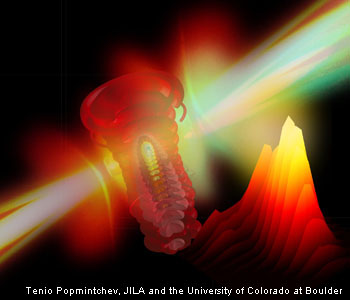Scatterings
Tabletop Supercontinuum X-Ray Source
An international team of scientists has developed a tabletop device that produces coherent bursts of shortwavelength radiation.
 An electron ripped from an atom by a strong laser field, which stretches its quantum wave function over hundreds of atomic sizes.
An electron ripped from an atom by a strong laser field, which stretches its quantum wave function over hundreds of atomic sizes.
An international team of scientists has developed a tabletop device that produces coherent bursts of short-wavelength radiation (Science 336, 1287). The compact source, powered by a mid-infrared laser, emits a wide range of wavelengths, from the extreme ultraviolet to the soft X-ray regime.
The supercontinuum X-ray source built at JILA (Boulder, Colo., U.S.A.) squeezes as many as 5,000 longer-wavelength photons together in the process known as high harmonic generation. Tenio Popmintchev, a senior research associate at JILA, and his team sent pulses from a 3.9-µm laser through a waveguide filled with high-pressure helium, which is the gas that is most transparent to X-rays. The coherent energy pulses strip electrons from the atoms and then smash them together to generate X-rays.
According to Popmintchev and JILA professor Margaret Murnane, phase matching of the light generated by the atoms is critical to ensure a coherent beam. Near-infrared laser pulses result in too much destructive interference in the X-ray region; paradoxically, the longer mid-infrared lasers proved to be just right for creating the most constructive interference.
The new source complements existing free-electron lasers (FELs), the only other sources of coherent X-rays. FELs require bulky, expensive electron accelerators to generate pulses over a relatively narrow spread of energies.
Andrius Baltuška and his colleagues at the Vienna University of Technology (Austria) developed the optical parametric chirped pulse amplification laser used in these experiments, which also involved researchers from Cornell University (U.S.A.) and the Universidad de Salamanca (Spain).
The scientists would like to increase the repetition rate of the supercontinuum source from the present 20 Hz and refine the equipment to generate pulses as short as 2.5 attoseconds. Such a focused X-ray beam could help scientists study chemical and biological processes. “Even electrons are almost ‘frozen’ at two-attosecond timescales,” Murnane says.
Log in or become a member to view the full text of this article.
This article may be available for purchase via the search at Optica Publishing Group.
Optica Members get the full text of Optics & Photonics News, plus a variety of other member benefits.
